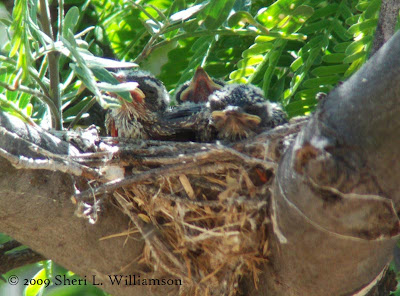Southeastern Arizona's dry season is usually locked in by late May, but the heat arrived a little early this year. Last week, Tucson was setting records with temperatures over 100° F., and even high, cool Bisbee was sweltering in the high 80s and low 90s. Then a high-pressure system settled in over the Four Corners - the typical "monsoon"pattern that draws moisture inland from the Gulf of Mexico. Clouds gathered, providing a welcome break from the almost-summer sun, but a few light sprinkles yesterday weren't much more than a tease.
Imagine my surprise walking out the door early this morning into drizzling rain and temperatures in the 50s. It rained off and on all morning in Miller Canyon, so I spent much of the morning's walk drying lenses on my binoculars and the spotting scope (I didn't even bother bringing the camera), but my small group and I were rewarded for our perseverance with views of several Red-faced Warblers, Painted Redstarts, singing male Hepatic Tanager and Black-headed Grosbeak, a Greater Pewee, and a pair of Spotted Owls.
Back home after the walk, I dried myself off, dug around in the closet for my fleece jacket and the fuzzy cap I crocheted this winter, and heated up a can of French onion soup and a cup of Mayan chocolate instant coffee—none of which would I have imagined doing in late May in southeastern Arizona.
 Extra credit if you figure out how we chose their names. As you can see, they're already bonding with Tom (though I think I heard Joni the prima donna cheep that he should use conditioner on his beard). --SW
Extra credit if you figure out how we chose their names. As you can see, they're already bonding with Tom (though I think I heard Joni the prima donna cheep that he should use conditioner on his beard). --SW






